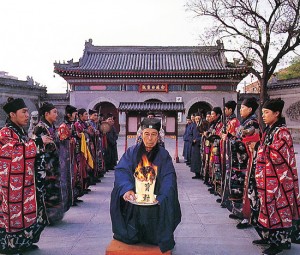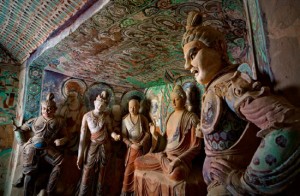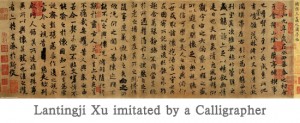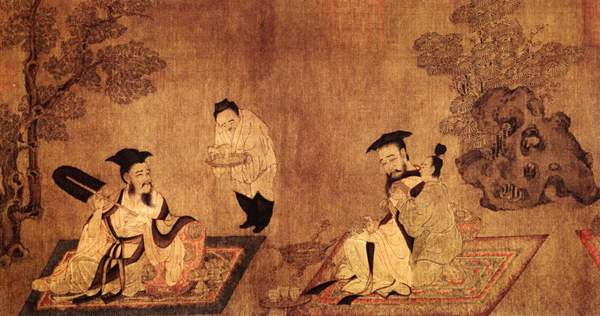Although the Jin Dynasty (265-420) was a time of brutal warfare and great political upheaval, the influx of tribal immigrants and the subsequent social change that took place during this dynasty also hugely influenced Chinese culture and art. In particular, the Jin Dynasty and the subsequent Northern and Southern Dynasties Period (420-589) represented a golden age for Buddhism and other belief systems. From the Mogao Caves of Dunhuang to the Maijishan Grottoes near Tianshui, Buddhism flourished not only as a belief system but also as an art form.
This spiritual shift began during the later Han Dynasty (206 BC–220 AD), when Confucianism slowly started to lose its prestige. By the beginning of the 3rd century, as it became more and more evident that the Han Dynasty was on the brink of collapse, scholars became gradually disillusioned with Confucian principles as they had failed to save the dynasty that had advocated them so strongly. This led to many scholars turning their attention to other schools of thought.
Within this intellectual movement, a new trend emerged and appeared to dominate the lives of the educated minority. This complex set of beliefs, known as xuanxue or “dark learning”, was based predominantly on three Taoist texts: the Zhouyi, the Tao Te Ching, and the Zhuangzi. Followers of xuanxue were preoccupied with ontological and metaphysical problems, but tackled these issues by incorporating ancient Chinese philosophies into their thinking. The idea was founded on the assumption that anything nameable, such as movement, change, and diversity, sprang from and was sustained by one detached principle, which was by definition unlimited, unnameable, unmoving, and unchanging.
In spite of its abstract nature, xuanxue became incredibly popular among the cultural circles of medieval China and enjoyed particularly prestige in the city of Jiankang (modern-day Nanjing). Renowned celebrities of the time, such as the poet Ji Kang, counted themselves among its supporters. Kang followed a popular branch of xuanxue known as “zhulin” or “bamboo wood”, which posited that people should work in harmony with the natural world and that the study of strict Confucianism destroyed this harmony. Thus it gradually became apparent that xuanxue represented the polar opposite of traditional Confucianism.
Yet, when it came to xuanxue, Confucius was regarded not simply as a great teacher but also as an enlightened sage. It was posited that Confucius had come to recognise the ultimate reality, but had chosen not to mention it is his teachings because it could not be expressed in words. This concept of Confucius’ “hidden saintliness” and the idea that he had an understanding of the world’s great mysteries would eventually play a huge part in Buddhist philosophy.
 So, while Confucianism appeared to be in a kind of spiritual hibernation, renewed interest was placed on Buddhism and Taoism. During the Han Dynasty, the suppression of various Taoist movements had left the religion fractured and it survived only in the form of small religious communities. Local Taoist masters became formidable social figures, as their charisma and spiritual significance gave them great power over the communities that they served. Thus the religion posed a major threat to the ruling government, as Taoist masters’ could radicalise their followers at a moment’s notice. This is the major reason why, unlike Buddhism, imperial courts rarely patronised Taoist communities, as they were believed to be unpredictable and anarchic.
So, while Confucianism appeared to be in a kind of spiritual hibernation, renewed interest was placed on Buddhism and Taoism. During the Han Dynasty, the suppression of various Taoist movements had left the religion fractured and it survived only in the form of small religious communities. Local Taoist masters became formidable social figures, as their charisma and spiritual significance gave them great power over the communities that they served. Thus the religion posed a major threat to the ruling government, as Taoist masters’ could radicalise their followers at a moment’s notice. This is the major reason why, unlike Buddhism, imperial courts rarely patronised Taoist communities, as they were believed to be unpredictable and anarchic.
Not only was it lacking in imperial support, but it seemed Taoism also had a fearsome adversary hot on its heels. Communal Taoist ceremonies, with their deafening music and fanatic fasting, were particularly objectionable to Buddhists because they were considered ecstatic and bordered on orgiastic. Not to mention the fact that they allowed women to take part, something unheard of in both Buddhist and Confucian tradition. The structural and doctrinal similarities between the two religions meant that people often conflated the two, which resulted in Buddhism spreading widely off of the back of Taoism’s popularity. Yet, in spite of these similarities, proponents of Buddhism and Taoism were bitterly opposed to one another.
 However, it was Buddhism that came out on top. From the 4th century onwards, this foreign religion gradually rose to become one of the major faiths in the country. The popularity of xuanxue greatly contributed to this, as the emphasis on complex philosophies and scholarly debate was a common factor between both schools of thought. Another potential reason for the religion’s popularity was the security that it offered. In an era devastated by war and rebellion, adopting the monastic life meant that even peasants could escape heavy taxation, enforced labour, relocation, and military conscription. At that time, pursuing an official career was riddled with corruption and danger, so many members of the gentry also opted to “take the cloth”, so to speak. Buddhist monasteries therefore became a place of equality, where everyone could enjoy a cultured and educated life regardless of their social standing.
However, it was Buddhism that came out on top. From the 4th century onwards, this foreign religion gradually rose to become one of the major faiths in the country. The popularity of xuanxue greatly contributed to this, as the emphasis on complex philosophies and scholarly debate was a common factor between both schools of thought. Another potential reason for the religion’s popularity was the security that it offered. In an era devastated by war and rebellion, adopting the monastic life meant that even peasants could escape heavy taxation, enforced labour, relocation, and military conscription. At that time, pursuing an official career was riddled with corruption and danger, so many members of the gentry also opted to “take the cloth”, so to speak. Buddhist monasteries therefore became a place of equality, where everyone could enjoy a cultured and educated life regardless of their social standing.
During the Sixteen Kingdoms Period (303-439), the tribal warlords who had taken over the north of China were strongly attracted to Buddhism, mainly due to the magical powers associated with Buddhist ritual. They had practical reasons for this preference as well, since Chinese ministers, who had ties to various clan members, were less politically reliable than unattached and unmarried Buddhist masters. These rulers proved to be some of the religion’s greatest patrons. It was thanks to them that the Mogao Caves, the Maijishan Grottoes, the Bingling Temple Grottoes, and many of the grottoes within the Hexi Corridor were constructed and developed.
 Aside from this abundance of Buddhist art, arguably the most notable event of the dynasty was the emergence of the calligrapher Wang Xizhi. His Lantingji Xu is considered the most valuable work of Chinese calligraphy, in spite of the fact that the original copy was lost during the Tang Dynasty (618-907). Although the Jin Dynasty may have been a time of political insecurity and violent warfare, it was also one characterised by great cultural progression in literature, art, philosophy, and religion. Along with the subsequent Northern and Southern Dynasties Period, it constituted one of the most creative periods in Chinese history. So, when it comes to the age old question: War, what is it good for? The answer is cultural change and artistic innovation, apparently.
Aside from this abundance of Buddhist art, arguably the most notable event of the dynasty was the emergence of the calligrapher Wang Xizhi. His Lantingji Xu is considered the most valuable work of Chinese calligraphy, in spite of the fact that the original copy was lost during the Tang Dynasty (618-907). Although the Jin Dynasty may have been a time of political insecurity and violent warfare, it was also one characterised by great cultural progression in literature, art, philosophy, and religion. Along with the subsequent Northern and Southern Dynasties Period, it constituted one of the most creative periods in Chinese history. So, when it comes to the age old question: War, what is it good for? The answer is cultural change and artistic innovation, apparently.
